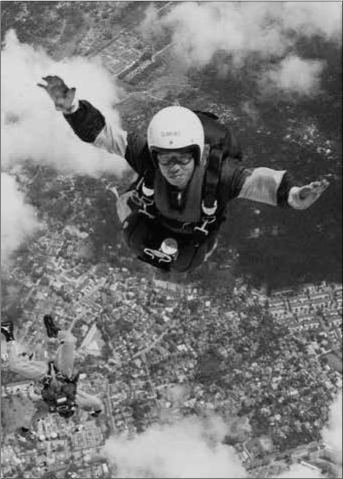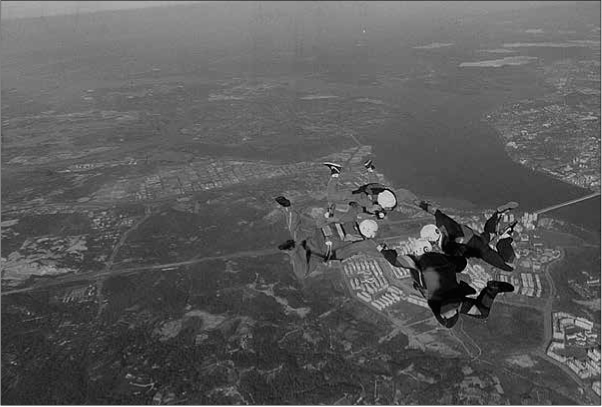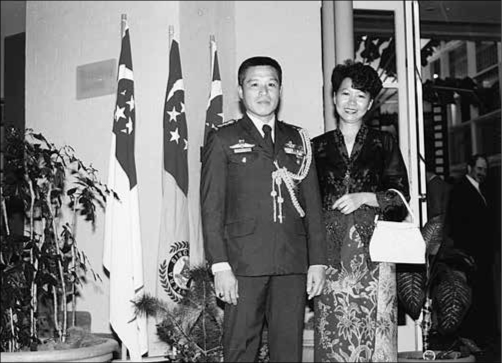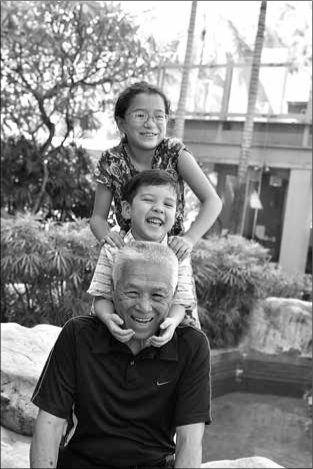
Freefalling over Singapore
The Laju hijacking and Operation Thunderstorm were arguably the last high-profile events that Clarence was directly involved in. There was a lesser known event in October 1977 that saw Clarence again working with the Minister of Defence, Dr Goh Keng Swee, in yet another hijack case. In that incident, four Vietnamese hijackers had taken over a Vietnamese Airlines DC-3 that was on a domestic flight out of Ho Chi Minh City, and diverted it to Singapore, via U-Tapao airport in Thailand. They were seeking asylum outside of Vietnam. In the process, during the flight two Vietnamese officials on board were killed. Commandos were placed on standby at Seletar Airport, where the aircraft landed, in case they needed to rescue the hostages. But the negotiators managed to resolve the situation with the hijackers giving themselves up without further bloodshed.
While there were no further high profile events during the mid to late 1970s, he was certainly kept busy with the continuing development of and growth of the commandos.
__________
Then in 1978, after nine years as a key member of the team that had built the commando unit from scratch, the time came for Clarence to hand the reigns of the 1st Commando Battalion over to a new face, and to take on a new role as the commander of the 2nd Singapore Infantry Brigade (2 SIB). He would spend eighteen months there before undertaking another 18-month posting to 5 SIB. Both these posting were very different to his experiences with the commandos. 2 SIB was purely infantry, and 5 SIB was a reserve brigade. But they both had their interesting and unique challenges.
During these three years away from the commandos, Clarence remained a commando at heart. As is the practice for vocational roles like commandos, he continued to wear his red beret and his commando-related badges, including those from the US Ranger and Airborne.
Following these postings he was posted back to the commandos as its commandant. Clarence would spend a further six years back with his home unit.
__________
Throughout these early days of the Singapore army, a great deal of ingenuity was required by everyone involved. Throughout his career Clarence demonstrated this many times, and perhaps one good example was on the parachuting front.
When he first returned from his US Airborne Course in the US, the army did not have a parachute unit at which he could continue to hone his skills. In fact, the only place to jump at the time was through a sports club run by the British Army’s Joint Services Sports Association. With the withdrawal of the British Army from Singapore, the Joint Services Sports Association was handed over to the Singapore Army Sport Association, with the parachuting section placed under the commando unit. Clarence and some of his colleagues took over this club, renamed it the Parachute Association of Singapore, and used it to introduce the regular commandos to parachuting. Being a sports club, they had to do all the activities outside of work hours, so training was conducted during weekday evenings and the jumps were made in the weekends.34 It also meant they could not do any military jump training, so they had a lot of fun doing free-fall jumps instead. Free-falling is where jumpers jump from a higher altitude, say, 10,000 feet, and fall freely down to around 3,000 feet before opening their parachute. During the free-fall phase they perform aerobatic manoeuvres, or set up various formations with other jumpers.

Freefalling over Singapore

Practicing formation jumps over Seletar. The Strait of Johor, separating Singapore from Malaysia, can be clearly seen, along with the Causeway connecting Singapore to Johor Bahru. Clarence is in black on the far right.
Once Clarence and his colleagues became competent at these formation jumps, they put on a few demonstration jumps for the Ministry of Defence, who were very impressed and encouraged them to continue. They even started doing jumps at some events for the general public. In those days, they only had access to round parachutes, which are pretty limited in their directional control. But being the resourceful man he was, when Singapore Airlines asked his team to perform at the opening of a new aircraft hangar, he managed to convince them to pay for some new square parachutes, which provided much better directional control.
Over the years of my listening to Clarence’s stories, and in speaking to others who knew him from his time with the commandos, I have the distinct impression that parachuting was an activity that he particularly enjoyed. And he certainly got to do a lot of it.
In late 1971, Clarence took his parachuting skills to another level and spent some time with a group known as the Golden Knights, in the US. These full-time parachutists are the US army’s demonstration and competition team, more formally known as the United States Army Parachute Team, and their job is to impress crowds through jumping at shows and competitions. Still in existence today, they do some pretty impressive aerobatic stunts while free-falling through the air. Jumping with these guys was far more intensive than what he had done up until then. They would begin their day at sunrise and jump all morning. An aircraft would take them up, then they would jump. Once back on terra firma, they would gather their parachutes, pack them back up, and head back up in the aircraft to do it all over again. Up and down all morning. After lunch, he and his fellow jumpers would sit around and watch a movie of their morning jumps, discuss their manoeuvres, then talk about their jumping plans for the following day. They lived, breathed, and ate jumping.
Clarence jumped all throughout his career, amassing over 1,300 jumps. It is an activity that has pretty serious risks associated with it, but he was able to come out of all those jumps with only one broken foot, sustained during a routine jump at Sembawang airforce base when he slipped on some wet grass while landing. It happens.
Marjorie recalls going out to the airfield in the weekends, when she was young, to watch him jump. Clarence would bring her along, and while he was up in the air the rigger girls, the team responsible for that very important task of packing the parachutes, would keep her entertained. She obviously caught a bit of the bug herself and tried her hand at it during her posting to New Zealand, even doing a free-fall from 10,000 feet on her first jump.
__________
By the mid-1980s, Singapore, New Zealand, and Australia already had long established military ties with each other. The Australians were heavily involved in the defence of Singapore against the Japanese in early 1942, and both New Zealand and Australia had maintained some form of presence in Singapore in the years following World War II. Both their armies had fought, and lost men, in the Emergency and the Confrontation. Admittedly the actual fighting in those campaigns was not on the island of Singapore itself, but Singapore was a base for many of them before they headed off into the jungles of Borneo and Peninsula Malaysia.
The Australians pulled their last troops from Singapore shores in 1974, but the establishment of the Five Power Defence Arrangements had obligated these three countries (plus Britain and Malaysia) to consult one another in the event that either Singapore or Malaysia should be attacked by a foreign army. The New Zealanders actually hung around quite a while longer, with the 1st Battalion Royal New Zealand Infantry Regiment only returning to their homeland in 1989. Additionally, Singapore had been conducting large-scale training exercises in Queensland since the mid-1970s, and Australian and New Zealand instructors were conducting courses for Singapore’s growing army.
Given the strong history, and ongoing military collaboration between Singapore and these two countries, it should not be surprising that the island nation had a Defence Adviser based at the Singapore High Commission in Canberra. And it was this role, a diplomatic posting as Singapore’s Defence Adviser to Australia (and New Zealand), that would end up being Clarence’s penultimate posting as an officer in the Singapore Armed Forces.
In November 1987, with Judy and Marjorie, now 16 years old, in tow (His son, Melvin – Kuku Mel – stayed behind in Singapore to complete National Service), he headed off to assume this new posting at the Singapore High Commission in the Australian capital, and a role that was arguably as different as he could get to all his military work so far. The ultimate in non-field-related positions: dinners, diplomatic functions, black tie events, lots of smiles and handshakes and pleasantries. And golf. But it was all work. Technically. Much of his time was spent negotiating for ongoing access to these countries’ land for training exercises, and opening up new areas. During his time he helped to gain access for Singapore forces to Rockhampton, Pearce Airforce Base, and Amberley Airforce Base in Australia and the Waiouru army training area in New Zealand.
The family spent four years in Australia before returning to Singapore in February 1992.
When he did return to Singapore following their time in Canberra, Clarence was appointed to the role of Senior Project Officer in the Ministry of Defense. However, shortly after returning, he was approached with an offer to run the Singapore office of a defence company. This gave Clarence cause to stop and rethink his plans. He had recently celebrated his 51st birthday, and for some time now had been considering the idea of trying something completely new. Given his age and his length of service, he was eligible for a pension, and this seemed like the perfect time to take that leap. So he accepted the offer.
Thirty-three years after starting his military career as a part-time solider with the Singapore Volunteer Corps, he handed in his notice and was approved for early retirement from 1st July 1992.
Clarence, your Kong Kong, was a civilian again.

Clarence and Judy hosting the Singapore Armed Forces Day function at the Singapore High Commission in Canberra, 1989

34 It would not be until 1974 when, with the help of an officer and a warrant officer from the New Zealand Army Parachute Training School, that a dedicated army parachute training school was set up in Singapore under the commandos, so that all commandos could learn how to do military parachuting.